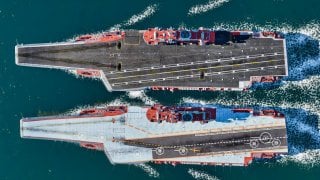Russia's Admiral Kuznetsov is the Worst Aircraft Carrier Ever Made
The Soviet-built Admiral Kuznetsov, intended as one of three aircraft carriers, suffered from the USSR's collapse, resulting in maintenance and technological challenges. Some say she is the worst aircraft carrier ever.
Summary: The Soviet-built Admiral Kuznetsov, intended as one of three carriers, suffered from the USSR's collapse, resulting in maintenance and technological challenges. It burns Mazut, a cheap but polluting fuel, lacks modern catapult systems for aircraft launch, and faces operational difficulties due to poor construction and maintenance. Despite its inadequacies, Russia maintains the Kuznetsov, fearing a capabilities gap with potential strategic implications for alliances, particularly with China. Many consider this the worst aircraft carrier ever made--and for good reasons.
Aircraft Carriers Sail Into History
Aircraft carriers are the ultimate symbols of national power projection. The United States has led the world in aircraft carrier operations ever since the Second World War. Back then, there were multiple powers with flat tops, not just the United States. In fact, the US Navy didn’t know what to do with the aircraft carriers it had built before the tragic events of December 7, 1941—Pearl Harbor.
It was the Imperial Japanese Navy that had pioneered the use of aircraft carriers as an offensive weapons platform. After all, the symbol of power projection back then was the battleship. But Japan did not attack Pearl Harbor with battleships. They used aircraft carriers. Similarly, the naval campaign of the Pacific Theater during the Second World War was not won by the battleship. It was won by the US Navy’s carrier force.
After World War II, the carrier remained as the pinnacle of naval power. Throughout the Cold War, American flat tops were the envy of the world. Whereas the Americans had mastered the art of aircraft carrier operations and had made the flat tops the basis of their surface fleet, the Soviet Red Navy lagged far behind the Americans. It was not until the 1980s that the Soviets even seriously contemplated building their own aircraft carrier. For decades, the Soviet Navy had made the heavy battlecruiser and submarines the basis of their navy’s power projection capabilities.
Geography’s Influence on the Russian Navy and Aircraft Carriers
The Soviet Union and, today, the Russian Federation is a predominantly land power. Occupying a large swathe of northern Eurasia, Russia has conducted its military operations usually across the continent as opposed to across the oceans, as so many other Western powers had done. This geographical reality has informed every aspect of Russian society. It explains why Russia is has trended toward autocracy. And why it took so long for Moscow to even contemplate building aircraft carriers.
By the time that Moscow opted to build an aircraft carrier, the Admiral Kuznetsov, was intended to be one of three carriers. Unfortunately for the Russians, the Cold War ended, and the Soviet Union died with it. What followed was chaos and poverty. Moscow retained control over its carrier but Russian experience maintaining a carrier—an inherently costly endeavor under the best of circumstances—was limited.
What’s more, the carrier was an incomplete mess heap that should have probably been scrapped or sold to the highest bidder (as was what happened to the Admiral Kuznetsov’s sister ship which became China’s first carrier, the Liaoning).
The Aircraft Carrier Admiral Kuznetsov’s Technical Limitations
Run on “a goopy, tar-like substance,” called Mazut, which is a petrochemical derivative, the Russian carrier was never as advanced as its American counterparts, which ran on more efficient and powerful nuclear energy. Mazut creates an amazing amount of pollution, so much, in fact, that it poses a health risk to sailors and to the equipment on the ship employing Mazut as a fuel source. Yet, it is relatively cheap and Russia being a petro-producing superpower, never has to worry about the supply chain for this low-grade fossil fuel being disrupted.
Burning this energy, though, creates security risks as well as health risks for the ship employing it. Namely, a large smoke trail, which can be seen for many miles, billows from the warship’s smokestack, and leaves a trail that would be easy for an enemy to track.
The carrier is an antique, too.
It uses neither a steam powered catapult nor an electromagnetic catapult, such as does the US Navy’s new Ford-class carriers do, to launch aircraft into the wild blue yonder. Instead, a ski jump ramp is used to help deploy fighter jets from the carrier. What this means, for all practical purposes, is that aircraft deploying from the Admiral Kuznetsov must be lighter than what they normally would be—meaning those aircraft must carry less armaments than they would, if they launched from another carrier that possessed a powered catapult system.
The infrastructure within the warship itself is shotty. Built during the terminal days of the Soviet Union, engineers at the Ukrainian shipyard where this jalopy was built cut significant corners. Cheap, ineffective pipesdegrade the efficiency to transfer pressurized Mazut to the engines. This has caused all kinds of knock-on problems for the carrier.
Then, of course, there’s the fact that the funding to maintain the aircraft carrier has been inconsistent and pretty much lacking. Thus, the carrier has been chock full of problems because of shabby maintenance schedules and inadequate parts.
Oh, and don’t forget all the engine woes the carrier has been made to endure. It’s gotten so bad for the carrier that, for many years, the warship was forced to travel with a tugboat. There has been long period when the carrier could not leave port because of all the maintenance issues.
A Hodgepodge of Broken Dreams & Lost Hopes
The Admiral Kuznetsov is a hodgepodge patchwork of broken dreams and lost hopes.
The only reason Moscow keeps dumping money into the warship is because the Kremlin fears the creation of a capabilities gap in its navy. Sure, Russia’s navy has nowhere near the level of experience managing carriers that the Americans do. But they don’t have to be on par with Washington in that domain. They just need to have some degree of knowledge—especially if, inevitably, China and Russia fuse their carrier programs on some level to counter the Americans, as I fear they will eventually do.
Those (limited) Russian carrier capabilities will be essential for helping China as much as China’s mass production capabilities will be critical for helping to establish a Russian carrier presence.
There is no doubt, though, the Admiral Kuznetsov is truly the worst aircraft carrier ever made. Certainly, it is the most dilapidated on the high seas (or not on the seas) today.
About the Author
Brandon J. Weichert is a former Congressional staffer and geopolitical analyst who is a contributor at The Washington Times, as well as at American Greatness and the Asia Times. He is the author of Winning Space: How America Remains a Superpower (Republic Book Publishers), Biohacked: China’s Race to Control Life, and The Shadow War: Iran’s Quest for Supremacy. Weichert can be followed via Twitter @WeTheBrandon.


